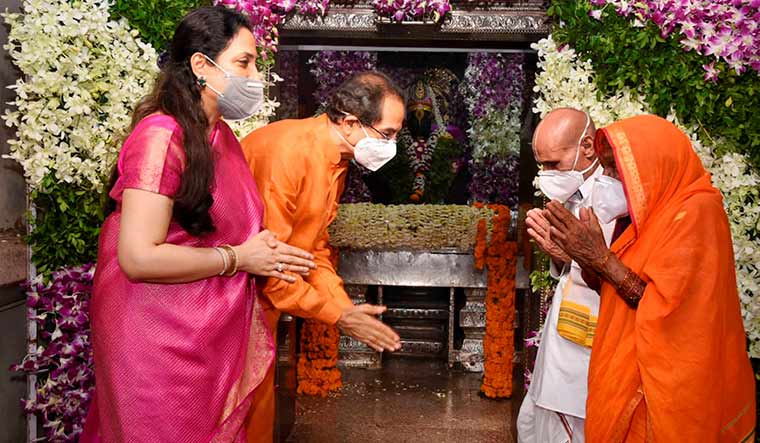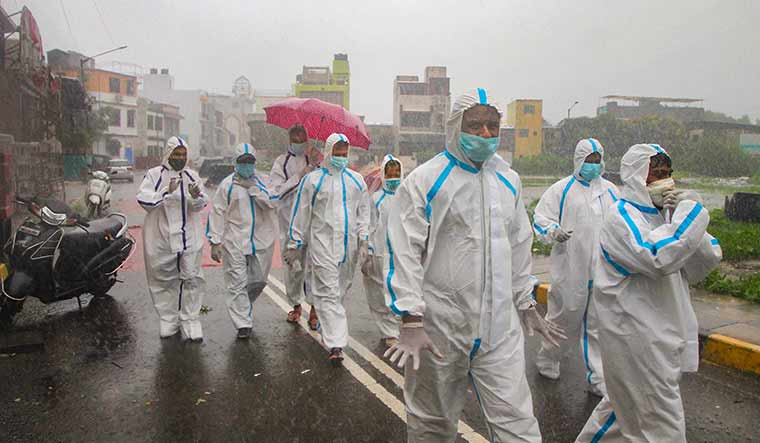ON JULY 1, Maharashtra Chief Minister Uddhav Thackeray went to Pandharpur, a pilgrimage town in Solapur district, with his wife and son Aditya, minister of tourism and environment. It was Ashadhi Ekadashi, a holy day for Hindus. Thackeray prayed for a miracle that would help not just Maharashtra—the Indian state worst affected by Covid-19—but the whole of mankind to get rid of the pandemic. Later, he reiterated this sentiment on Twitter, saying that man was down on his knees and there was no cure for the disease, yet.
The chief minister, who had in the past maintained that the state was doing extremely well in its fight against Covid-19 and assured people victory over the virus, showed the first signs of fatigue and resignation with his entreaty for divine intervention. As of July 5, over two lakh people had been infected in Maharashtra and close to 9,000 had died. With over 84,000 cases, Mumbai accounted for 41 per cent of the total.
The heavy showers in the state’s Konkan regions could compound the problem as monsoon-related illnesses would overload the already strained health infrastructure. “Our biggest worry is how we will differentiate those with malaria, leptospirosis and dengue from those with Covid-19,” says Dr Harshad Limaye, internal medicine specialist at Nanavati Hospital in Mumbai. “We are also expecting a few cases of swine flu. The already acute bed-availability crisis might worsen anytime now.”
After a steep spike in cases during Unlock 1, the chief minister decided to restrict movement in Mumbai. The police imposed a new rule asking citizens to move only within a 2km radius from their homes; only office-goers were exempt. The sudden enforcement of the rule caught many unawares and evoked strong reactions from those who were fined and had their vehicles seized.
The Congress and the Nationalist Congress Party—partners in the ruling alliance—expressed displeasure that ministers from the allies, including Home Minister Anil Deshmukh of the NCP, were not kept in the loop by the chief minister’s office before asking Mumbai Police to enforce the blockade. Similarly, a 10-day lockdown was imposed in Thane, despite a difference of opinion between Housing Minister Jitendra Awhad of the NCP and the Shiv Sena’s Eknath Shinde, minister for urban development and public works. After ministers from the NCP complained to party chief Sharad Pawar that they were not being taken into confidence by the chief minister, Pawar met Thackeray and the periphery blockade in Mumbai was withdrawn. But, the chief minister was adamant that strict restrictions were needed in the corporations neighbouring Mumbai.
Meanwhile, shortage of health care personnel is leading to extreme working conditions. “There is burnout and confusion among civilians and frontline workers,” said Swati Rane, vice president, Clinical Nursing and Research Society. “I know of a nursing hostel in Pune where bouncers were sent to ensure that nurses kept working for 12 hours at a stretch, despite their protests. The government continues to face staff shortage and many have to work for inhuman hours. IAS officers alone cannot manage Mumbai, especially when those in the wards have no idea what to do.” A structure is lacking and decentralisation is the need of the hour, she adds.
Most experts and health activists agree that Mumbai’s Covid-19 numbers have stabilised to an extent over time. But, the relentless rise in cases in the Mumbai Metropolitan Region (MMR) is adding to the city’s case load. These fringe towns, which include Navi Mumbai, Mira-Bhayandar, Ulhasnagar, Kalyan Dombivli, Thane, Ambernath, Badlapur and Bhiwandi, have contributed over 15,000 cases so far. “These towns do not have the infrastructure to fight a pandemic,” says Brinelle D’Souza, assistant professor at Tata Institute of Social Sciences, and co-convener of Jan Swasthya Abhiyan’s Mumbai chapter. “Covid-19 patients from these areas are coming to the city’s hospitals and testing facilities. So one cannot actually say that Mumbai has gotten over the pandemic unless the other corporations, too, report a decrease in numbers. Right now, there seems to be a lack of coordination between MCGM (Municipal Corporation of Greater Mumbai) and the eight other corporations of the MMR, which share boundaries and depend so much on each other for human resources.”
In a bid to get a grip on the situation, the government deputed four IAS officers with medical backgrounds as municipal commissioners. Sudhakar Deshmukh, municipal commissioner of Panvel Municipal Corporation (PMC), told THE WEEK that 90 per cent of the infections in PMC were from Mumbai. “Residents here go to Mumbai for work and catch the infection because of lack of social distancing and spread it here,” he says. Seven of the nine municipal corporations in the MMR are now in lockdown and the Brihanmumbai Municipal Corporation (BMC) is hoping to build giant Covid-19 care facilities on the city’s periphery.
Additional chief secretary, S.J. Kunte, who is in charge of tackling Covid-19 in the MMR, says that this situation was expected because of the unlocking and restarting of local trains to ferry passengers for essential services. “Now, the point is to trace, track and test cases and minimise the spread,” he says. “We are trying to manage, but we have no manpower,” says Kunte. “They (doctors) ask for a lot of money to serve and we are asking corporations to pay up to Rs1.10 lakh, instead of the Rs75,000 per month stipulated by the National Health Mission. That is the only way.”
On July 4, the cabinet secretary held a meeting in which he stated that the fatality rate should be brought down to 1 per cent. Mumbai’s fatality rate is close to 6 per cent; the state average is 4.49 per cent and the national average is 2.9 per cent, according to the Medical Education and Drugs Department, Maharashtra.
The BMC had already come up with a nine-point strategy—Save Lives—on June 30 to reduce Covid-19 fatality. It includes closer monitoring of critical patients, including video surveillance by heads of units and heads of hospitals, among other aspects.”The number of positive cases are declining, but the city’s ICUs remain largely full,” says Dr Om Shrivastav, member of the state Covid-19 task force. “In the next few weeks, we will know how effective it (Save Lives) is.”
Another important initiative has been Project Platina—a convalescent plasma therapy trial, which will be free of cost in 17 medical colleges across the state—launched by the chief minister on June 29.
Even as Mumbai continues to report over 1,000 cases a day, there is a silver lining. Dharavi, which was once a Covid-19 hotspot, reported significantly fewer cases at the start of July. The load has now shifted from the slums to the city’s high-rises as residents step out of their homes and get house help back in. For instance, housing complexes in the city’s D Ward, which includes “posh” localities such as Malabar Hill, Gamdevi and Nepean Sea Road, witnessed a surge in cases in June.
To make things worse, even as people desperately try to save their loved ones, private hospitals continue to charge a premium for hospital beds and present the patient’s families with exorbitant bills. This has not gone unnoticed and, on July 4, Santacruz police registered an FIR against Nanavati Hospital for allegedly charging Rs2 lakh per bed per night.



